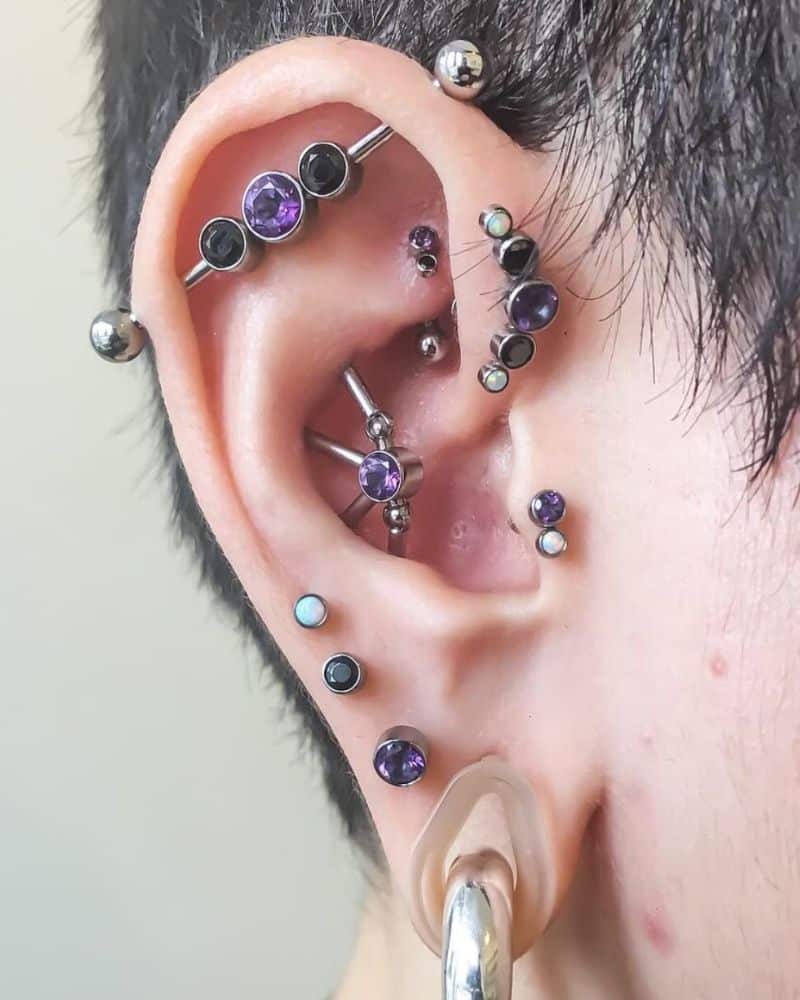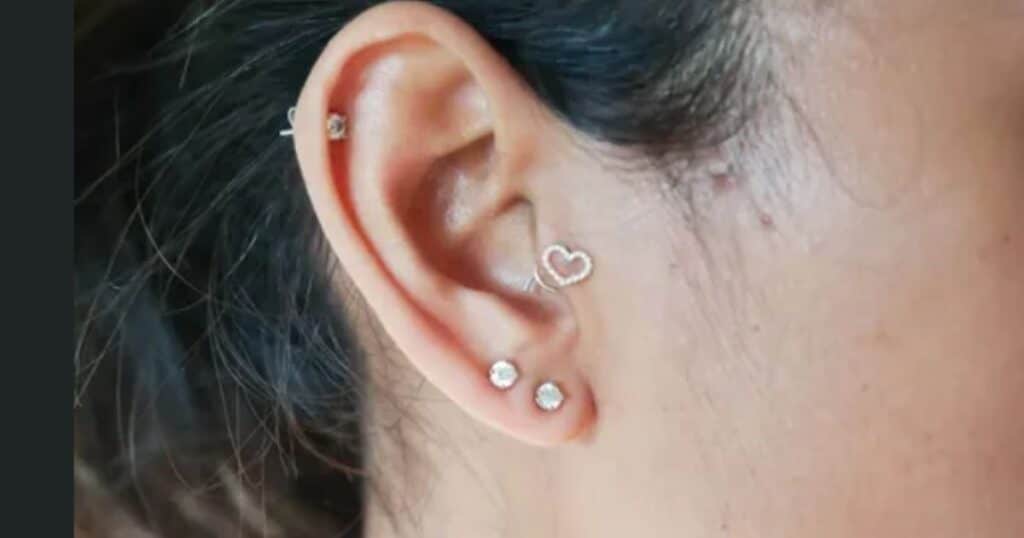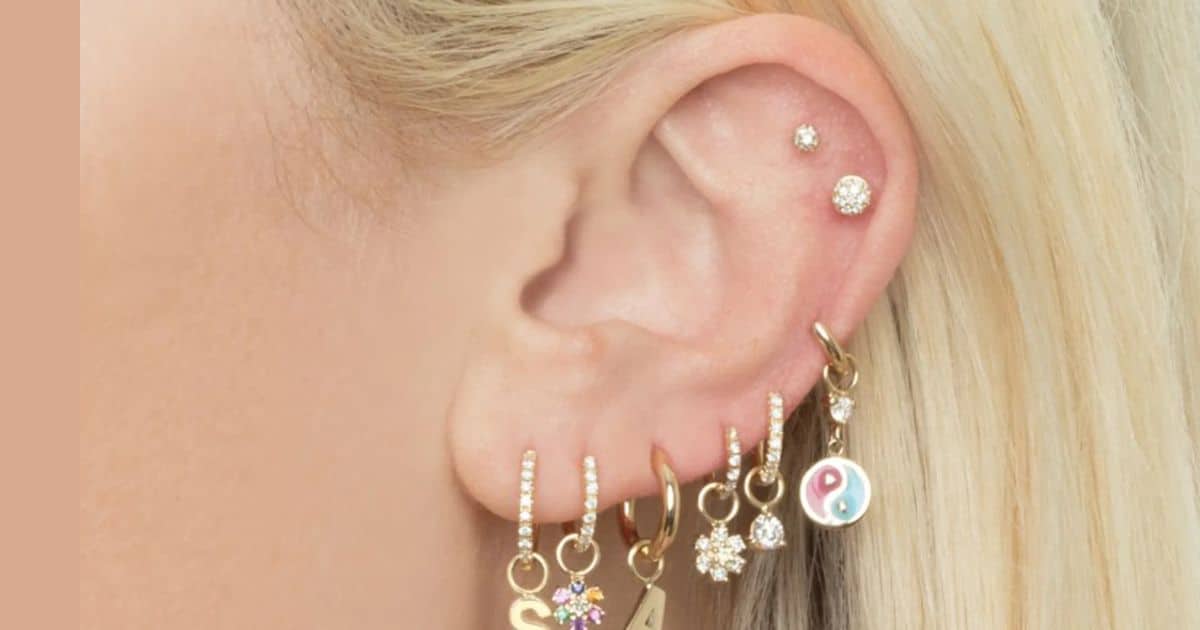Ear piercing placement is choosing where to put jewelry in your ears. It can be on the lobe, cartilage, or other ear parts. Different spots create unique looks and styles.
Are you thinking about getting your ears pierced? Wondering where to put that new stud or hoop? This guide will help you decide. We’ll explore various ear-piercing options and what they offer.
Choosing the right spot for your piercing matters. It affects healing, comfort, and style. This guide covers popular placements, their benefits, and things to consider. Let’s find your perfect ear piercing placement
Lobe Piercings

Lobe piercings are the most common type of ear piercing. They’re done on the soft, fleshy part at the bottom of your ear. These piercings are popular because they’re easy to get and heal quickly. You can have one lobe piercing or several in a row.
Lobe piercings work well for all ages and genders. They offer many options for jewelry styles. You can wear studs, hoops, or dangly earrings in lobe piercings. When choosing lobe placement, think about symmetry and your personal style.
More Post:
HIFU Eye Lift Treatment – Non Surgical Technique
Cartilage Piercings
Cartilage piercings are done on the firmer upper parts of your ear. They’re more edgy than lobe piercings. There are many types, like helix and conch piercings. These piercings take longer to heal than lobe piercings.
Your ear shape matters for cartilage piercings. Some ears work better for high piercings, others for low ones. The thickness of your ear cartilage also affects placement options. Cartilage piercings can add a unique touch to your look.
They’re great for those wanting something different.
Tragus and Daith Piercings

Tragus and daith piercings are unique ear piercings. The tragus is the small flap at the front of your ear canal. Daith piercings go through the innermost fold of cartilage. These piercings have become popular recently.
They stand out and look bold. Tragus and daith piercings can be tricky to get. They might take longer to heal than other piercings. But many people like them for their special look. These piercings can add interest to your ear jewelry collection.
More Post:
4D and 7D HIFU – Main differences of 2 newest skin tightening techniques
Rook and Forward Helix Piercings
Rook and forward helix piercings are more complex ear piercings. The rook is in the upper inner fold of ear cartilage. The forward helix is on the outer rim near the top of the ear. These piercings give a modern, stylish look.
They’re not suitable for all ear shapes. Rook and forward helix piercings need careful placement. They can be painful and take longer to heal. But they offer a unique way to decorate your ears.
These piercings are great for those wanting something less common.
Considerations for Placement

When choosing where to get your ear pierced, think about a few things. Your ear shape matters. Some piercings look better on certain ear types. Healing time is important, too. Cartilage piercings take longer to heal than lobe piercings.
Consider what jewelry you want to wear. Some spots limit your jewelry choices. It’s best to talk to a professional piercer. They can look at your ears and give good advice. They’ll help you pick a spot that fits your style and ear shape.
Anatomy
Your ear shape is important when choosing a piercing spot. Everyone’s ears are different. Some are big, some are small. Some have thick cartilage, others thin. These differences affect where piercings can go.
Some placements might look great on one ear but not on another. A good piercer will check your ear anatomy. They’ll help you find spots that work best for your ears. This ensures your piercing looks good and feels comfortable.
Healing Time
Different ear piercings heal at different speeds. Lobe piercings usually heal the fastest. They can take about 6-8 weeks. Cartilage piercings take much longer. They might need 3-12 months to fully heal. Healing time depends on the piercing location.
It also depends on how well you care for it. Some people heal faster than others. Remember, a piercing isn’t fully healed just because it looks okay. Follow your piercer’s advice about healing time. Be patient and take good care of your new piercing.
Jewelry Options
The piercing spot affects what jewelry you can wear. Lobe piercings offer the most options. You can wear studs, hoops, or dangly earrings. Cartilage piercings often need smaller, flatter jewelry. Some spots, like the tragus, work best with specific types of earrings.
Think about what jewelry you want to wear long-term. This can help you choose the right piercing spot. Some placements limit your jewelry choices. Ask your piercer about jewelry options for each spot. They can show you what works best for different piercing
Professional Advice
The piercing spot affects what jewelry you can wear. Lobe piercings offer the most options. You can wear studs, hoops, or dangly earrings. Cartilage piercings often need smaller, flatter jewelry. Some spots, like the tragus, work best with specific types of earrings.
Think about what jewelry you want to wear long-term. This can help you choose the right piercing spot. Some placements limit your jewelry choices. Ask your piercer about jewelry options for each spot. They can show you what works best for different piercings.
FAQs
How to decide ear piercing placement?
Consider your ear anatomy, personal style, and desired jewelry. Consult a professional piercer for personalized advice based on your unique features.
How do you know if ear piercing will suit you?
Try temporary stick-on earrings or use photo editing apps to visualize the look. Consider your lifestyle and workplace dress codes. Discuss with a piercer for professional input.
What is the rarest ear piercing?
The snug piercing is considered one of the rarest. It’s a horizontal piercing through the inner ridge of cartilage, above the anti-tragus. It’s challenging to perform and not suitable for all ear shapes.
Where is the most painful ear piercing placement?
Pain is subjective, but generally, cartilage piercings like the industrial or rook are considered more painful. The daith and tragus can also be quite sensitive due to their location and thickness of cartilage.

Welcome to Fashioneens! Your go-to destination for trendy fashion tips and style guides. Join us in exploring the latest in fashion trends and unleash your inner style icon!








